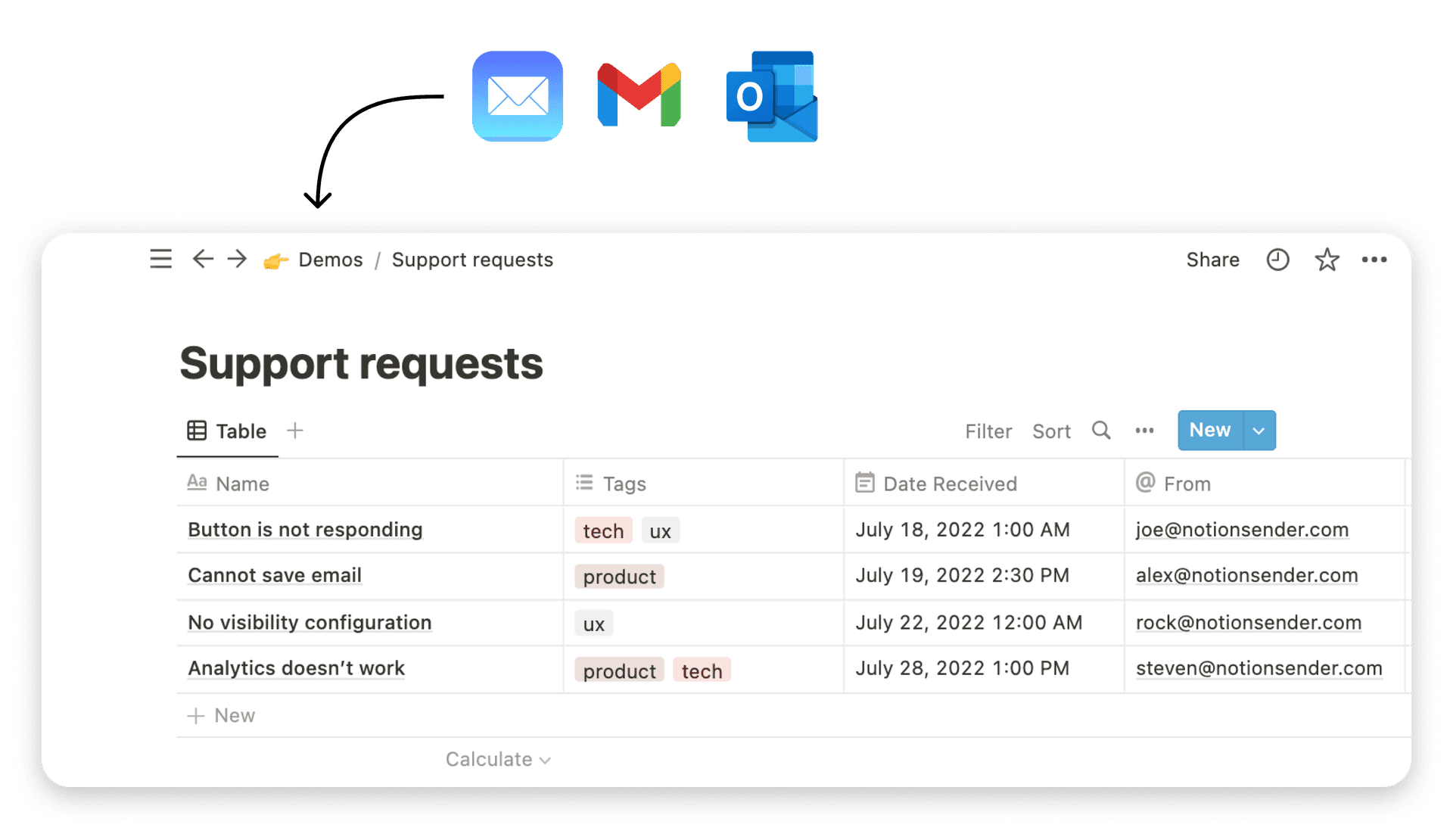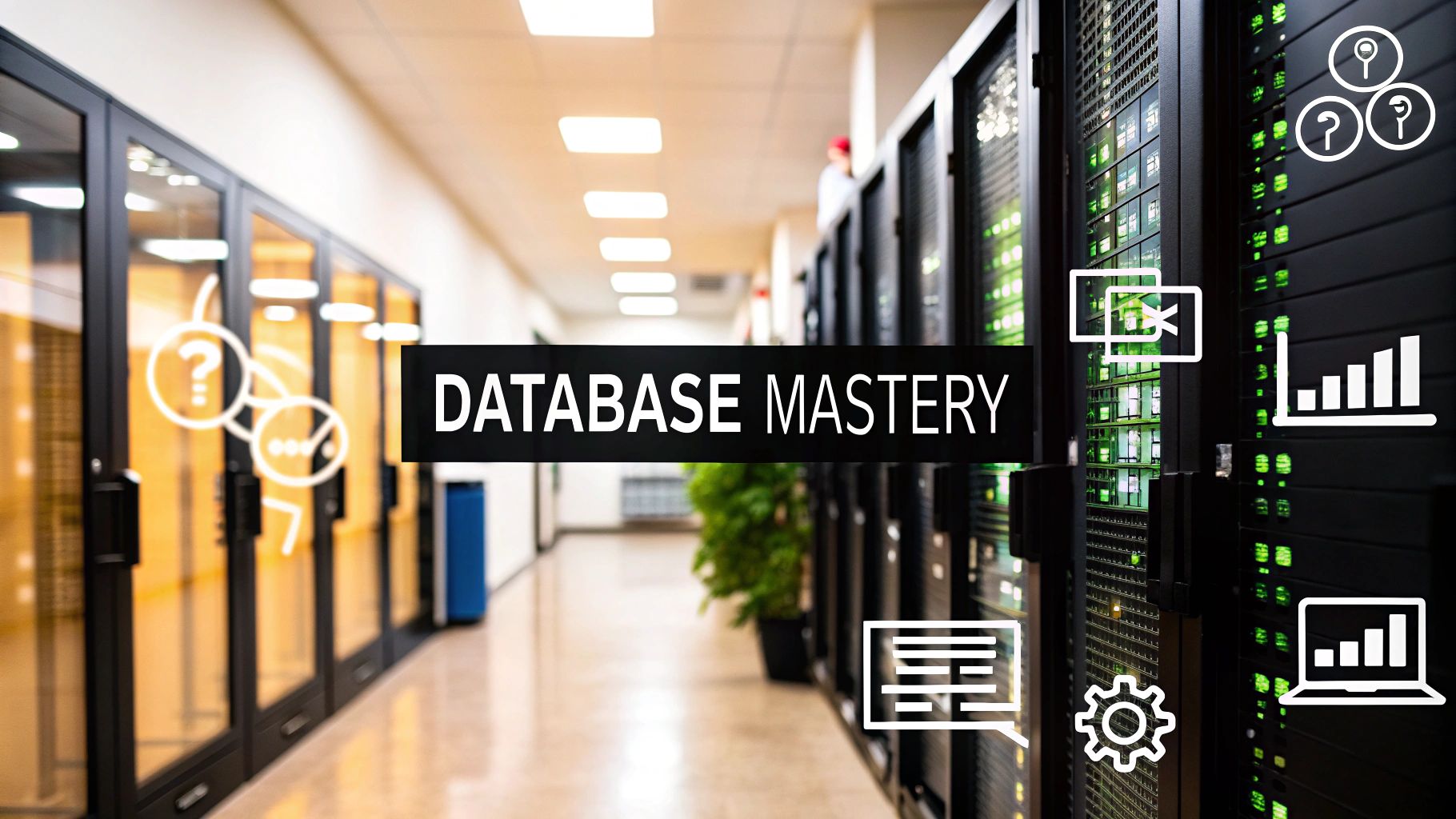Top 10 Best Email Automation Tools for 2025

Email isn't just about sending messages; it's about building relationships at scale. In today's competitive landscape, manually managing campaigns, follow-ups, and customer journeys is no longer sustainable. The right automation platform can transform your strategy from a time-consuming chore into a powerful, revenue-generating engine. This is where finding one of the best email automation tools becomes critical for growth.
But with so many options, how do you choose? This guide cuts through the noise. We'll dive deep into 12 top-tier platforms, analyzing not just what they do, but who they're for. Whether you're a freelancer, a growing e-commerce brand, or a B2B marketer, we've identified the ideal solution for your specific needs, budget, and technical comfort level.
This isn't a generic feature list. For each tool, you will find:
- A concise summary of its core strengths.
- Detailed analysis of key features and pricing.
- Honest pros and cons based on real use cases.
- Screenshots and direct links to get you started faster.
Our goal is to help you move beyond simple email blasts and implement sophisticated workflows that nurture leads, engage customers, and drive sales automatically. To truly harness the power of these tools, it's essential to understand the broader context of marketing automation. For further insights into effective strategies, explore these best practices in marketing automation. Let's find the platform that will become your new secret weapon.
1. NotionSender: Best for Integrating Email into Project Management Workflows
NotionSender stands out as a uniquely powerful tool, not as a traditional email service provider, but as a bridge that transforms your Notion workspace into a dynamic email automation hub. Its core value lies in deeply integrating email communication directly into project management workflows, eliminating the constant context-switching that kills productivity. It’s built for teams and individuals who live inside Notion and want to manage client communication, support tickets, or sales inquiries without leaving their primary workspace.
The platform's standout feature is the ability to assign a unique email address to any Notion database. This simple concept unlocks powerful automations: when an email is sent to that address, NotionSender captures it and creates a new entry in your database. Its AI-powered data extraction then intelligently parses the email content, automatically populating properties like sender name, subject, and even specific details from the email body into your designated fields.
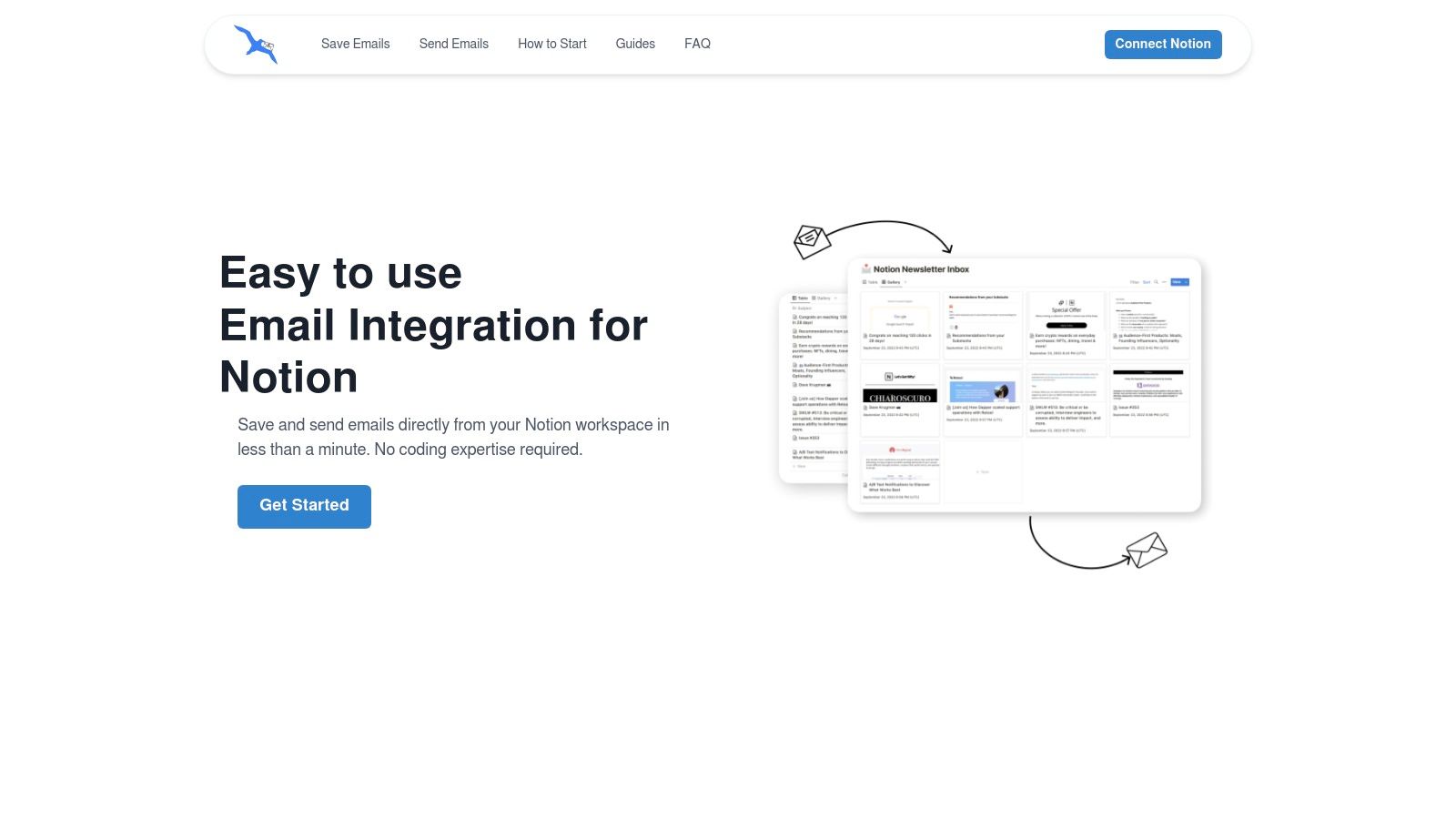
Key Features and Use Cases
NotionSender excels by turning a static project tool into an active communication center. The no-code, one-minute setup makes it incredibly accessible even for non-technical users.
- Automated Data Entry: A support team can use a dedicated email (e.g.,
support@yourteam.notionsender.com) linked to a "Tickets" database. The AI automatically fills in the user's name, issue summary, and priority, creating a new ticket instantly. - Centralized Client Communication: Freelancers and agencies can manage all client correspondence within a specific Notion project page, keeping emails, attachments, and project tasks in one unified view.
- Outbound Email Automation: You can also send personalized, templated emails directly from a Notion page. A sales team could trigger a welcome email sequence whenever a new lead's status is changed to "Contacted" in their CRM database. For a deeper dive, you can learn more about how to create and send emails directly from Notion.
Pricing and Limitations
NotionSender offers a tiered pricing model that accommodates various needs, including a generous free plan perfect for low-volume users or for testing its capabilities.
| Plan | Price | Key Features | Best For |
|---|---|---|---|
| Free | $0/month | 50 emails/month, 1 database connection, basic AI | Individuals or small projects |
| Pro | Starts at $9/month | 1,000+ emails/month, unlimited databases, advanced AI | Professionals and small teams |
| Business | Custom | High volume, priority support, team features | Larger teams and organizations |
Pros:
- Seamlessly centralizes email within your primary project management tool.
- AI-powered data extraction saves significant time on manual data entry.
- Enables powerful, context-aware automation workflows inside Notion.
- Extremely user-friendly interface with no coding required.
Cons:
- Primarily benefits existing Notion users; not a standalone email marketing platform.
- The 10MB attachment limit on incoming emails can be restrictive for certain workflows.
- High-volume sending requires upgrading to a paid plan for higher limits.
Website: https://www.notionsender.com
2. Mailchimp
Mailchimp is one of the most recognizable names in email marketing, renowned for its user-friendly interface that makes it an excellent entry point for small businesses and freelancers. Its strength lies in balancing simplicity with a powerful set of features, positioning it as one of the best email automation tools for teams that need to start quickly and scale over time. The platform’s visual Customer Journey Builder allows you to map out automation workflows with drag-and-drop ease, using pre-built templates for common scenarios like abandoned carts or welcome series.
This approachable design philosophy extends to its huge library of professional templates and clear deliverability reporting, which helps demystify the process of getting emails into the inbox.
Key Features & Use Cases
Beyond basic campaigns, Mailchimp offers a surprisingly robust ecosystem. Its transactional email service (formerly Mandrill) is a powerful add-on for sending automated receipts and notifications. With over 300 integrations, it connects seamlessly with popular e-commerce platforms like Shopify and WooCommerce, making it ideal for online store owners.
- Best For: Small to mid-size e-commerce businesses, content creators, and startups seeking an all-in-one marketing platform.
- Standout Feature: The Customer Journey Builder's visual interface is exceptionally intuitive, allowing non-technical users to create sophisticated, multi-step automations based on user behavior.
- Pricing: Offers a generous Free plan for up to 500 contacts. Paid plans start with Essentials ($13/month), unlocking A/B testing and advanced automation. A pay-as-you-go credit model is also available for infrequent senders.
Pros and Cons
| Pros | Cons |
|---|---|
| Very easy to get started with an intuitive UI. | Advanced automation features are locked to higher-tier plans. |
| Huge library of professional-looking templates. | Overage charges can be costly if you exceed contact or send limits. |
| Scales well from a free plan to enterprise-level tools. | Mailchimp branding is mandatory on the Free plan. |
| Flexible pay-as-you-go credit option is available. | SMS marketing is an add-on and not included in the Free plan. |
Website: https://mailchimp.com
3. HubSpot Marketing Hub
HubSpot Marketing Hub is a powerhouse platform that goes far beyond standard email marketing, offering a fully integrated solution built around its world-class CRM. This tight integration is its core strength, allowing businesses to create deeply personalized email automations based on a complete view of a contact's entire lifecycle. From their first website visit to their most recent sales call, every data point can be used to trigger sophisticated workflows, making HubSpot one of the best email automation tools for teams that need to align marketing, sales, and service efforts.
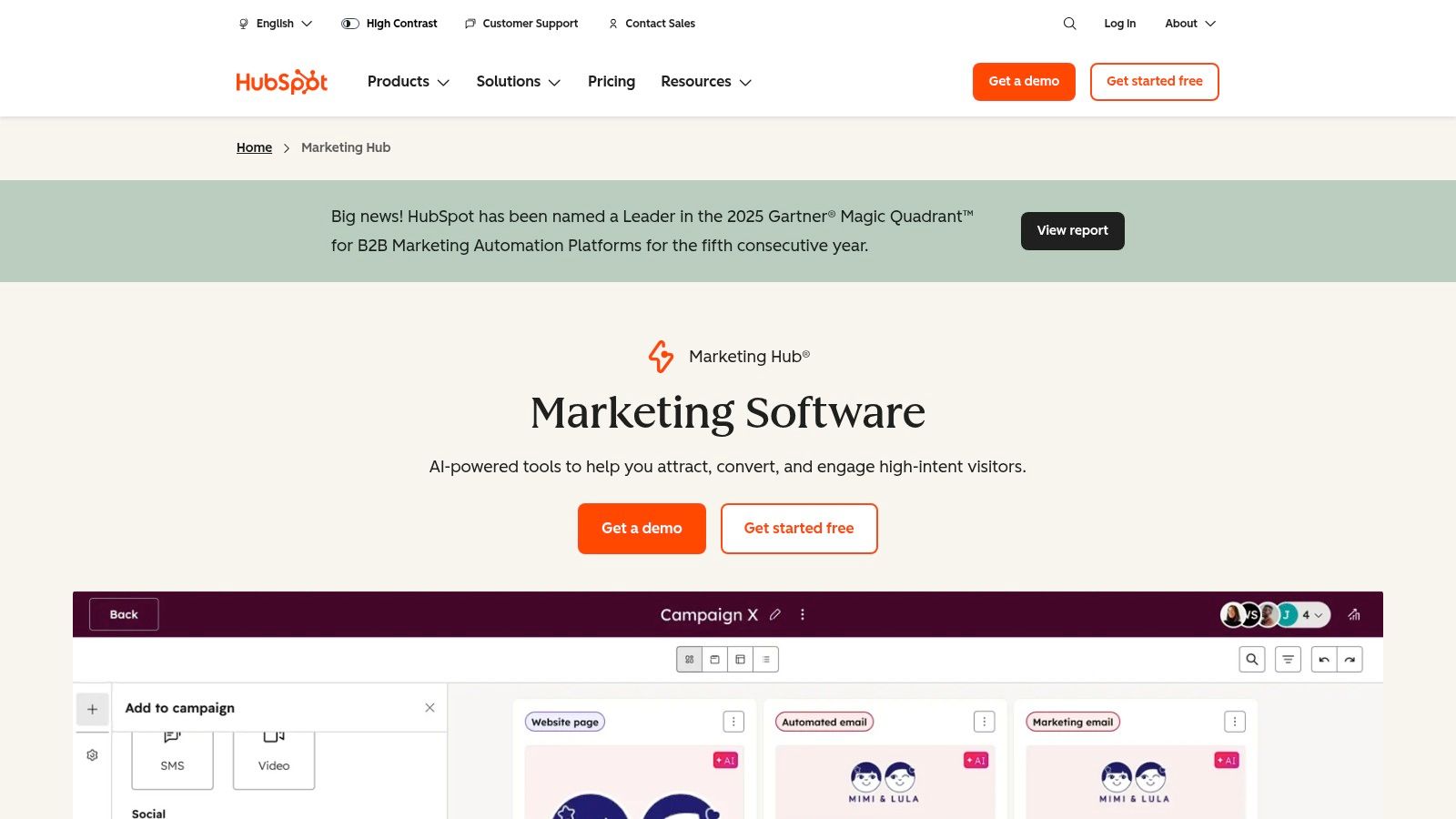
Its visual workflow builder is powerful, enabling complex if/then branching logic that can adapt a customer’s journey in real-time. This ensures that every email sent is not just automated but also highly relevant and contextual. For tips on maximizing engagement, you can increase your open rates with these email marketing tricks.
Key Features & Use Cases
HubSpot’s ecosystem is vast, connecting email to lead scoring, ad management, social media, and advanced analytics. You can build workflows that automatically assign leads to sales reps, update contact properties based on email engagement, or enroll customers in specific nurture sequences after a purchase. This makes it an ideal central hub for all marketing activities.
- Best For: B2B companies and businesses with longer sales cycles that need to connect email automation directly to CRM data and sales activities.
- Standout Feature: The native CRM integration allows for unparalleled lifecycle automation, where email workflows can be triggered by sales activities, service tickets, and website behavior for a truly unified customer experience.
- Pricing: Offers a suite of Free tools to get started. Paid plans begin with Starter ($18/month), but advanced automation and workflows require the Professional plan, which has a higher price point and mandatory onboarding fees.
Pros and Cons
| Pros | Cons |
|---|---|
| Unbeatable native CRM integration for 360-degree customer view. | The contact and seat-based pricing model can become expensive as you grow. |
| Scales from a generous set of free tools to enterprise-level features. | Mandatory, paid onboarding is required for Professional and Enterprise tiers. |
| All-in-one platform includes tools for content, social media, and ads. | Advanced features are locked behind higher-priced plans. |
| Powerful visual workflow builder with complex branching logic. | The platform can have a steep learning curve due to its extensive capabilities. |
Website: https://www.hubspot.com/products/marketing
4. ActiveCampaign
ActiveCampaign is a powerful, automation-first platform designed for businesses that want to go beyond simple email blasts. It excels at creating deeply personalized customer experiences by combining email marketing, marketing automation, and CRM tools. Its reputation as one of the best email automation tools is built on a sophisticated yet manageable visual workflow builder that allows for complex, logic-based sequences without requiring extensive technical expertise.
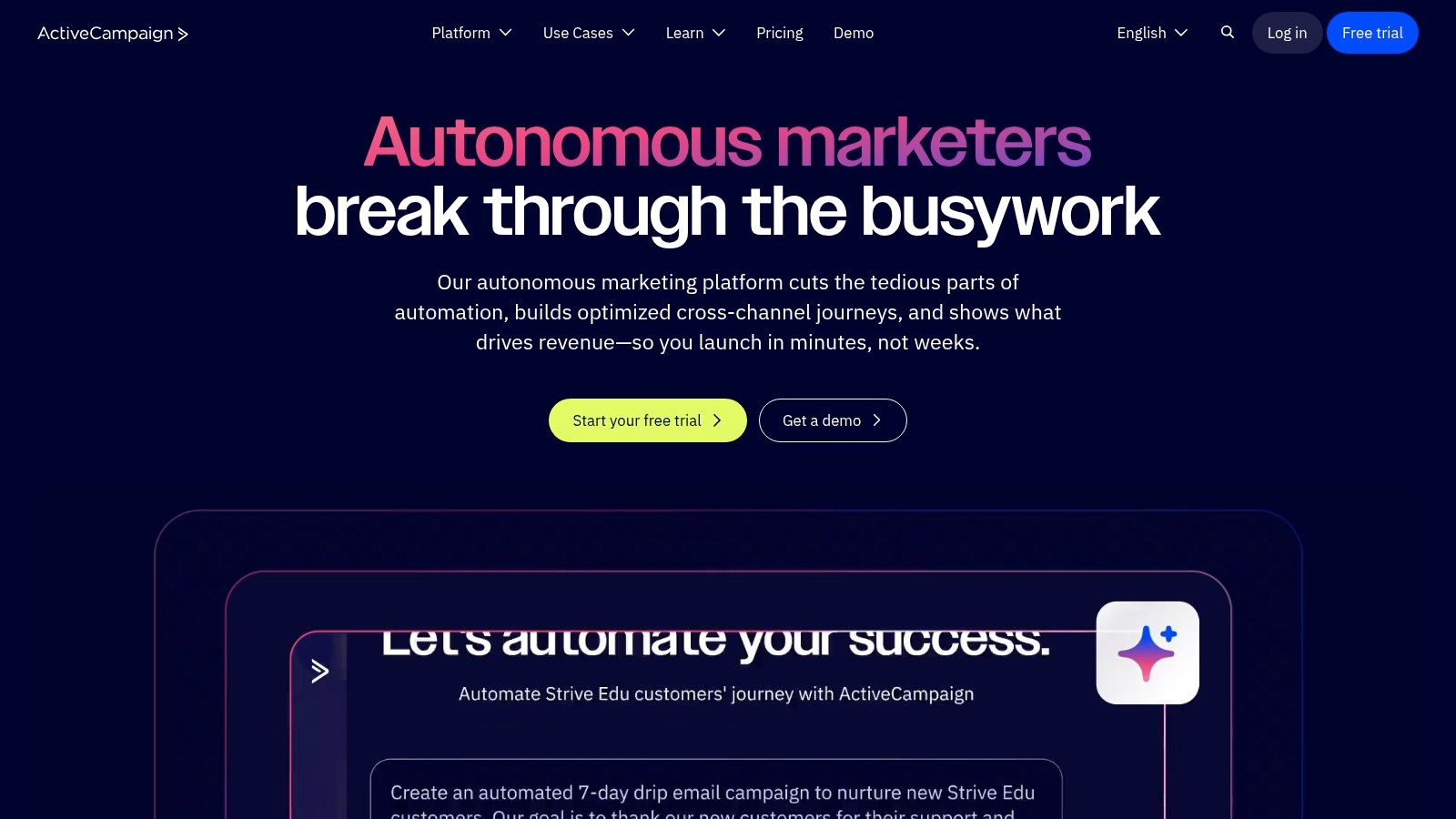
This focus on advanced automation makes it a favorite for SMBs and mid-market companies that have outgrown simpler tools and need more granular control over segmentation and customer journeys. With pre-built "automation recipes" and AI-assisted content suggestions, users can quickly launch effective campaigns. Managing these complex workflows is a key part of success, and adopting strong email management tips can help maximize the platform's potential.
Key Features & Use Cases
ActiveCampaign’s real strength is its ability to trigger automations from a wide range of user actions, including website visits, purchases, and email engagement. With over 900 integrations, it connects to nearly any tool in a modern marketing stack, from Shopify to Salesforce. The platform also offers features like site tracking, lead scoring, and SMS marketing, allowing you to build a complete picture of each customer.
- Best For: B2B companies, SaaS businesses, and experienced marketers who need robust automation and CRM capabilities in one place.
- Standout Feature: The visual automation builder provides unparalleled flexibility, allowing for conditional logic (if/then/else), split actions, and goal tracking within a single workflow.
- Pricing: Starts with the Marketing Lite plan at $29/month. A free 14-day trial is available, and new users benefit from free 1:1 strategy sessions and migrations.
Pros and Cons
| Pros | Cons |
|---|---|
| Powerful visual automation builder with advanced logic. | The sheer number of features can have a steep learning curve. |
| Excellent deliverability reputation and a strong focus on inbox placement. | Contact-based pricing can become complex as your list grows. |
| Over 900 integrations provide extensive connectivity. | Advanced reporting and custom objects are locked to higher tiers. |
| Offers a free 14-day trial and complimentary migration service. | Some users find the interface less intuitive than simpler tools. |
Website: https://www.activecampaign.com
5. Klaviyo
Klaviyo has solidified its position as the go-to platform for data-driven e-commerce brands, especially those in the direct-to-consumer space. While many tools can send emails, Klaviyo excels at using deep customer data to power highly personalized and profitable automations. It integrates tightly with platforms like Shopify and WooCommerce, pulling in product feeds, purchase history, and browsing behavior to create rich customer profiles. This makes it one of the best email automation tools for businesses that want to tie every campaign directly to revenue.
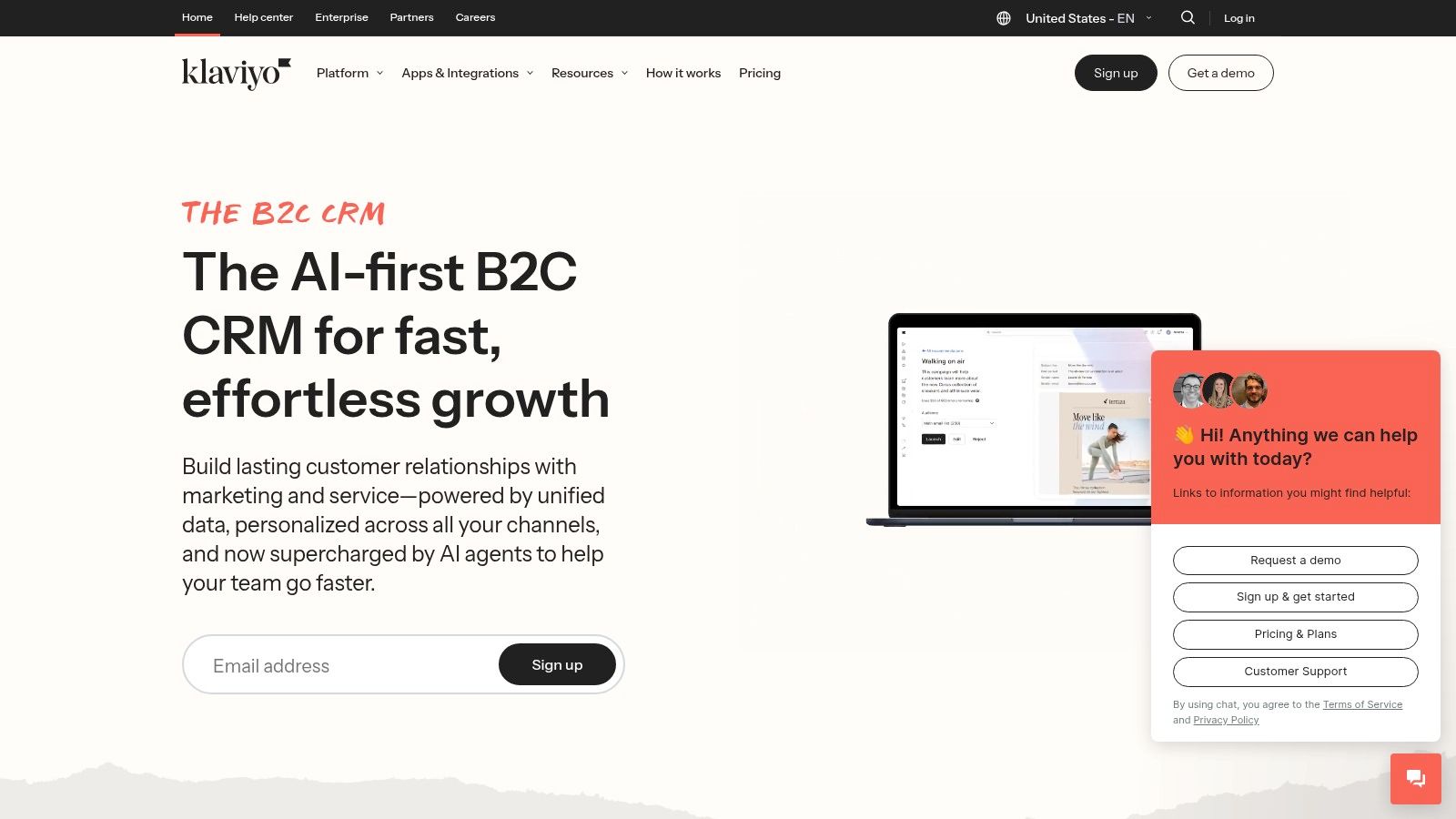
Its powerful flow builder comes equipped with pre-built e-commerce templates for scenarios like abandoned checkouts, browse abandonment, and price drop alerts, allowing stores to implement sophisticated strategies quickly. The platform’s reporting is uniquely focused on revenue attribution, showing exactly how much money each email and SMS message generates.
Key Features & Use Cases
Klaviyo’s real power lies in its combined email and SMS marketing capabilities, allowing for unified, multi-channel customer journeys within a single workflow. With over 350 integrations and a growing set of AI-powered features like predictive analytics and a subject line assistant, it helps merchants work smarter. Advanced customer data platform (CDP) features are also available as an add-on for enterprise-level analytics.
- Best For: E-commerce stores, particularly direct-to-consumer (DTC) brands on Shopify, WooCommerce, or BigCommerce.
- Standout Feature: Revenue-centric reporting and deep e-commerce data integration. The ability to build segments based on predictive analytics, like a customer's likelihood to churn, is incredibly powerful.
- Pricing: Offers a Free plan for up to 250 contacts and 500 email sends. Paid plans like Email (starting at $20/month) scale based on the number of active contacts, with combined Email and SMS plans also available.
Pros and Cons
| Pros | Cons |
|---|---|
| Unparalleled e-commerce data integration and triggers. | Pricing rises quickly as your list of active profiles grows. |
| Scales effectively from a free plan to very large businesses. | Billable-profile policies can lead to unexpected costs after list cleaning. |
| Pre-built, revenue-generating automation flow templates. | SMS costs vary significantly by country and require careful budget management. |
| Robust segmentation and predictive analytics capabilities. | The interface can be complex for users new to advanced automation. |
Website: https://www.klaviyo.com
6. Brevo (formerly Sendinblue)
Brevo, formerly known as Sendinblue, stands out as a powerful, all-in-one marketing platform that extends far beyond email. It has carved out a niche by offering an impressive suite of tools, including SMS marketing, live chat, and a built-in CRM, at a highly competitive price point. This makes it one of the best email automation tools for businesses seeking a unified platform to manage their entire customer communication funnel without breaking the bank. Brevo's strength lies in its generous pricing model, which is based on email volume rather than contact list size, allowing businesses to grow their audience without facing immediate cost increases.
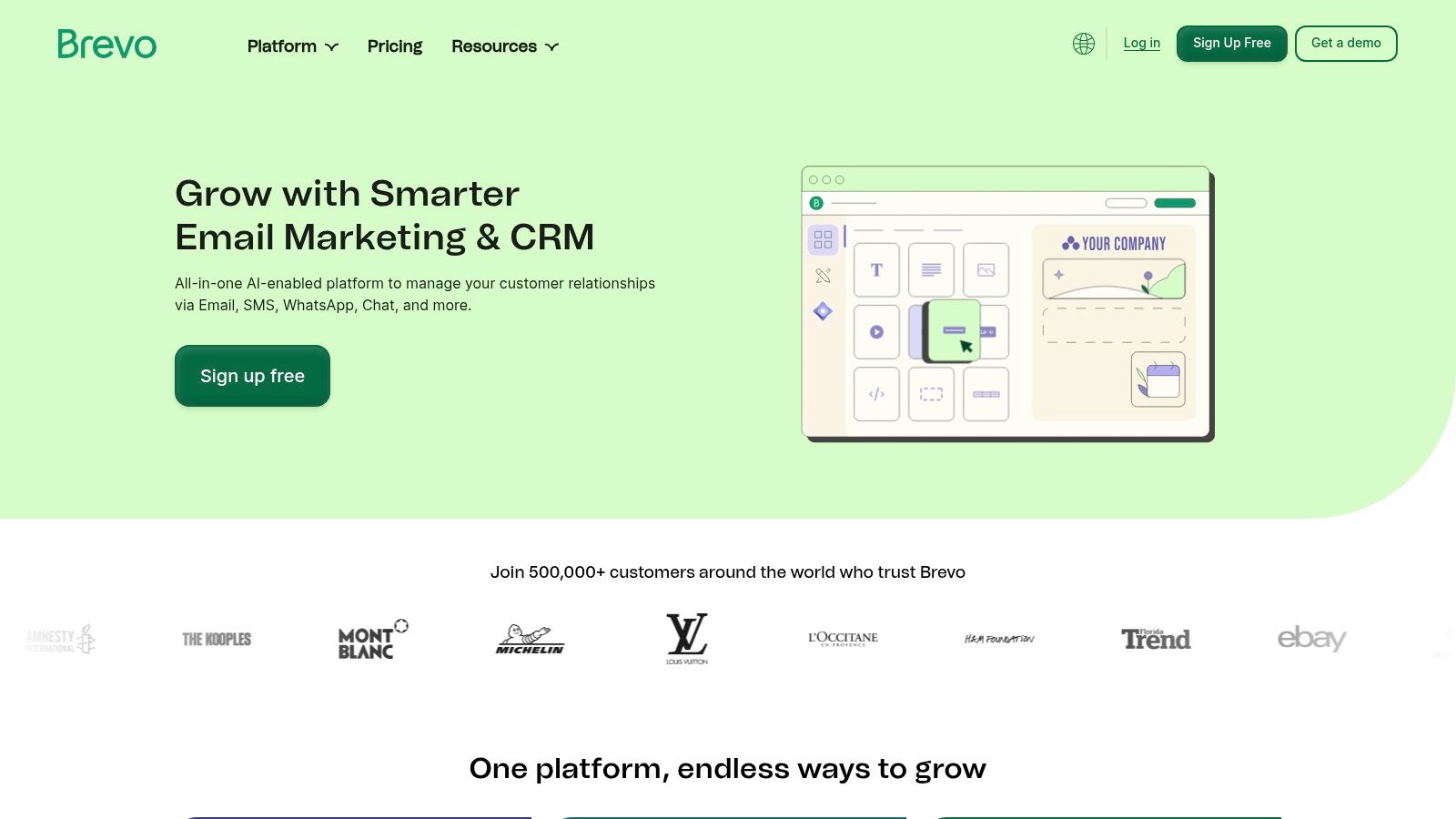
The platform's workflow editor is robust, enabling users to create multi-channel automations that combine email, SMS, and contact updates. This positions Brevo as an excellent solution for marketers who want to orchestrate more complex, cross-channel customer journeys.
Key Features & Use Cases
Brevo's feature set is designed for comprehensive marketing management. Its transactional email and SMS APIs are reliable and easy to integrate, making it a go-to for developers and businesses needing to send order confirmations or password resets. The platform also includes send-time optimization, which analyzes user engagement to deliver messages when they are most likely to be opened.
- Best For: Budget-conscious small to medium-sized businesses and startups that need a multi-channel marketing suite (email, SMS, chat, CRM) in one place.
- Standout Feature: The combination of a generous free plan with unlimited contacts and an affordable pricing structure based on send volume offers exceptional value for growing businesses.
- Pricing: Offers a Free plan with unlimited contacts and up to 300 emails/day. Paid plans start with Starter ($25/month), removing the daily sending limit, and Business ($65/month) which adds marketing automation and A/B testing.
Pros and Cons
| Pros | Cons |
|---|---|
| Excellent all-in-one value (email, SMS, chat, CRM). | Advanced automation and A/B testing require higher-tier plans. |
| Unlimited contact storage on all plans, including Free. | The user interface can feel less intuitive than some competitors. |
| Competitive pricing based on email sends, not contacts. | Support responsiveness can vary on lower-priced plans. |
| Strong transactional email and SMS API included. | Some features, like advanced analytics, are locked to premium plans. |
Website: https://www.brevo.com
7. MailerLite
MailerLite has carved out a space as one of the best email automation tools by combining simplicity with a powerful, all-in-one digital marketing toolkit. It’s an ideal choice for creators, bloggers, and small businesses who need more than just email, offering built-in features for landing pages, websites, and even selling digital products. Its core strength is its clean, uncluttered user experience that makes creating sophisticated automations feel intuitive and straightforward.
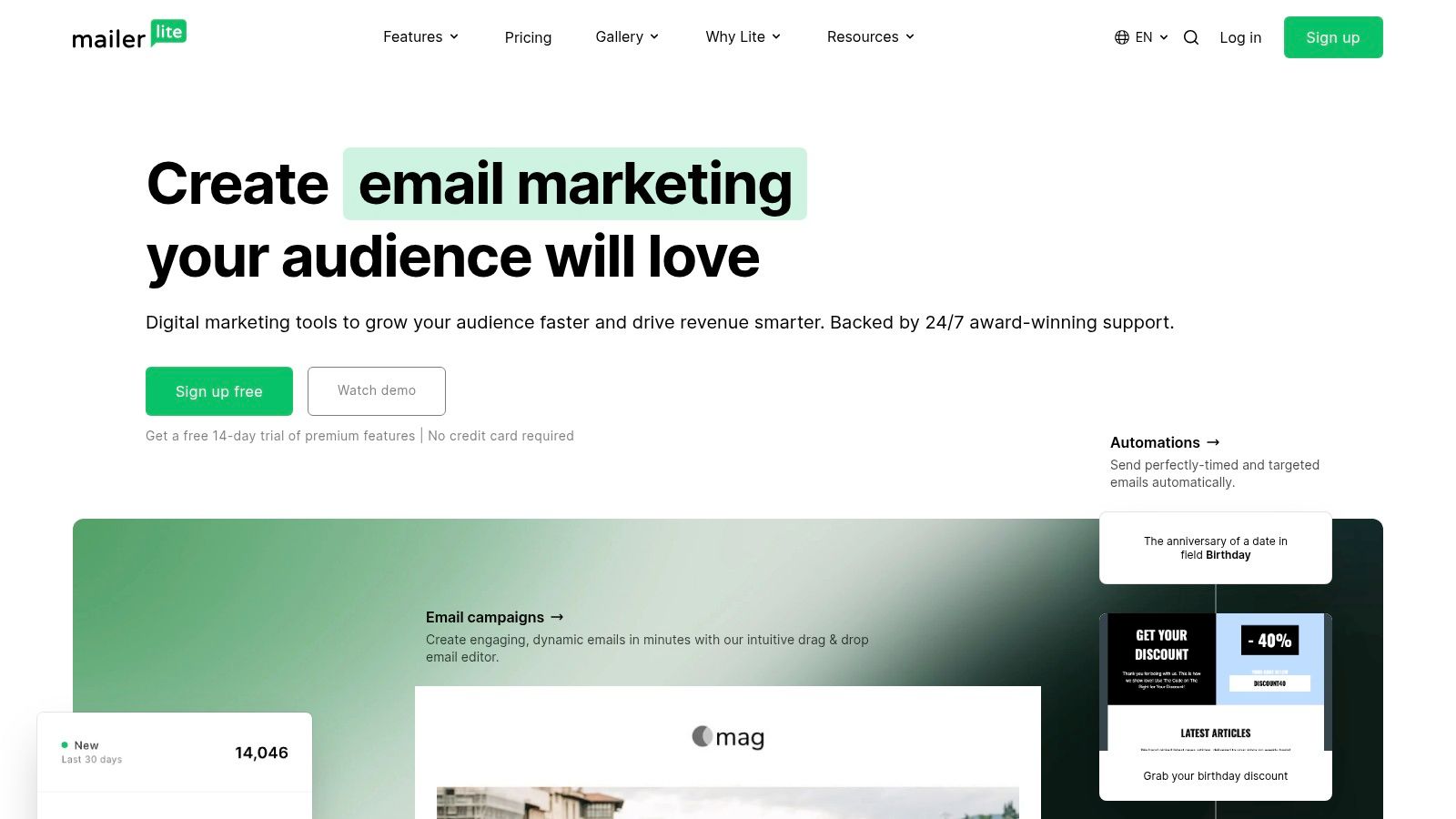
The platform’s visual workflow builder allows users to easily set up multi-step sequences triggered by subscriber actions, such as joining a group or clicking a link. This accessibility, paired with its affordable and transparent pricing, makes MailerLite a top contender for users seeking high-value features without a steep learning curve or high cost.
Key Features & Use Cases
Beyond standard automation, MailerLite excels at providing tools that support the entire creator economy. The integrated website and landing page builder means you can capture leads and send them directly into an automation sequence without needing a separate tool. It’s also one of the few platforms in its class to offer integrated digital product sales, perfect for selling e-books or online courses.
- Best For: Content creators, freelancers, and small businesses needing an affordable, all-in-one solution for email, landing pages, and digital sales.
- Standout Feature: The combination of an intuitive automation builder with built-in e-commerce and landing page functionality provides incredible value in a single platform.
- Pricing: A generous Free plan is available for up to 1,000 subscribers and 12,000 monthly emails. The Growing Business plan starts at $10/month, unlocking unlimited emails and the ability to sell digital products.
Pros and Cons
| Pros | Cons |
|---|---|
| Very easy to use with a clean and modern UX. | Fewer native integrations for enterprise-level software. |
| Transparent pricing offers strong value. | Some advanced support channels are limited to higher-tier plans. |
| Includes landing pages, websites, and blogs. | Automation trigger options are less complex than some competitors. |
| Generous free plan with essential features included. | The initial account approval process can sometimes be strict. |
Website: https://www.mailerlite.com
8. Constant Contact
Constant Contact has long been a staple in the email marketing world, especially for small businesses and non-profits that need a straightforward, reliable platform. It distinguishes itself by offering more than just email, integrating tools for event management, social media posting, and basic e-commerce. As one of the best email automation tools for beginners, its focus is on ease-of-use and excellent customer support, making it less intimidating than more complex systems. The platform provides pre-built automation templates for welcome sequences and nurturing leads, guided by a simple, linear workflow builder.
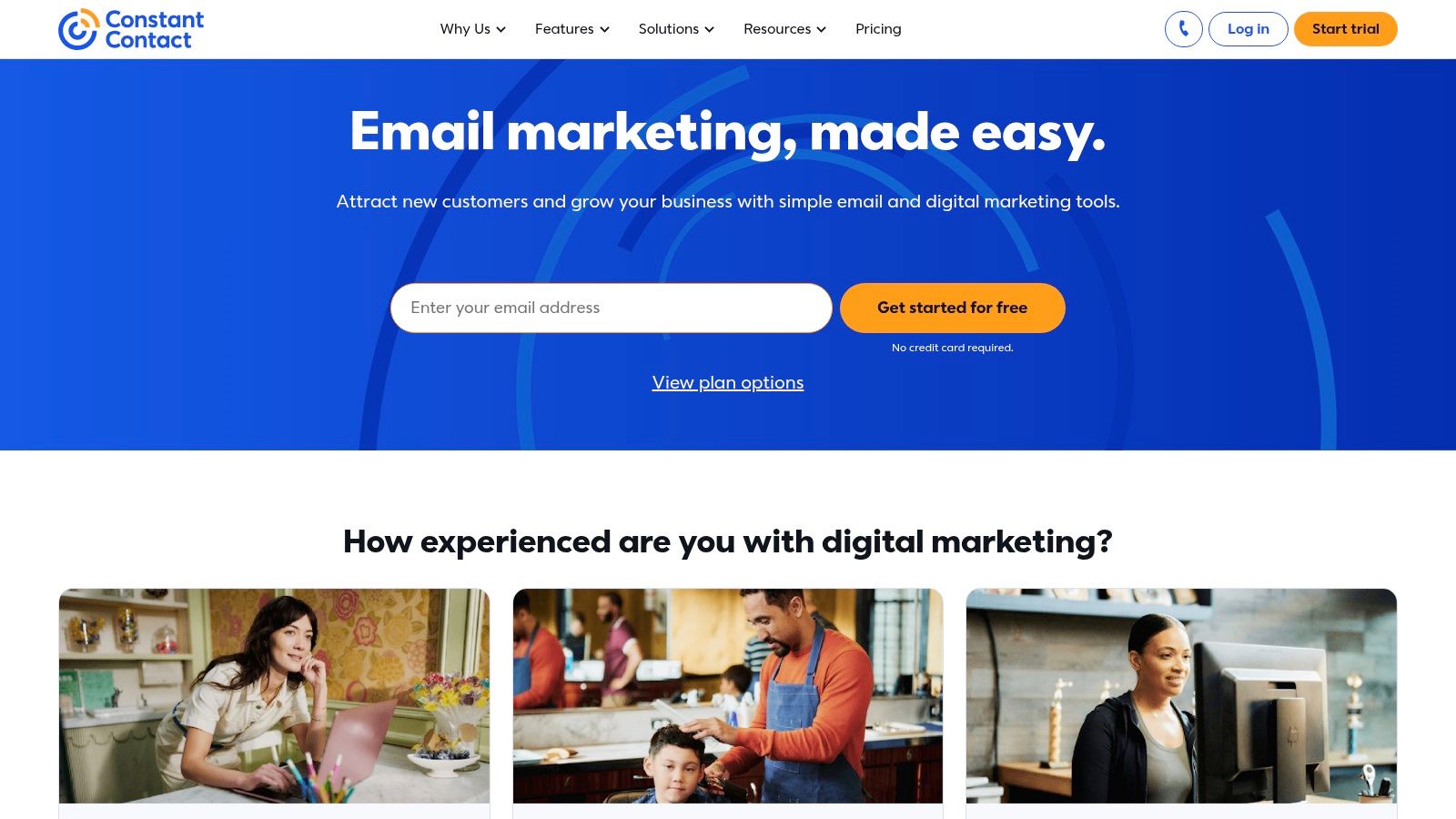
This approachability, combined with live phone and chat support, ensures that even users without technical expertise can set up and run effective campaigns quickly.
Key Features & Use Cases
Beyond standard email campaigns, Constant Contact shines in its niche integrations. The built-in event marketing tools are perfect for businesses that host webinars, workshops, or community events, allowing for seamless invitation, registration, and follow-up automation. With over 300 integrations, it connects to key platforms, though its primary value lies in being an all-in-one solution for foundational marketing tasks.
- Best For: Small businesses, non-profits, and event-driven organizations that need an easy-to-use marketing suite with strong customer support.
- Standout Feature: The integrated event management functionality, which handles everything from registration pages to automated reminders, is a unique and powerful feature not commonly found in email-centric platforms.
- Pricing: The Lite plan starts at $12/month for basic email sends. The Standard plan ($35/month) unlocks core automation features and A/B testing, while the Premium plan ($80/month) adds advanced segmentation and SEO tools.
Pros and Cons
| Pros | Cons |
|---|---|
| Extremely user-friendly and approachable for non-marketers. | Advanced segmentation and automation are locked behind the most expensive plan. |
| Excellent live customer support via phone and chat. | Can become costly as contact lists or monthly email volumes grow. |
| Integrated tools for event marketing and social media. | The workflow builder is less flexible than visual editors from competitors. |
| Clear monthly send allowances with a predictable overage policy. | Template designs can feel slightly less modern than some alternatives. |
Website: https://www.constantcontact.com
9. Drip
Drip is a powerful marketing automation engine built specifically for e-commerce. It moves beyond standard email marketing by focusing intently on the customer journey, using deep integrations with platforms like Shopify, WooCommerce, and BigCommerce to trigger automations based on real-time customer behavior and purchase data. Its entire philosophy is geared toward helping online stores build relationships and drive repeat sales, positioning it as one of the best email automation tools for revenue-focused brands.
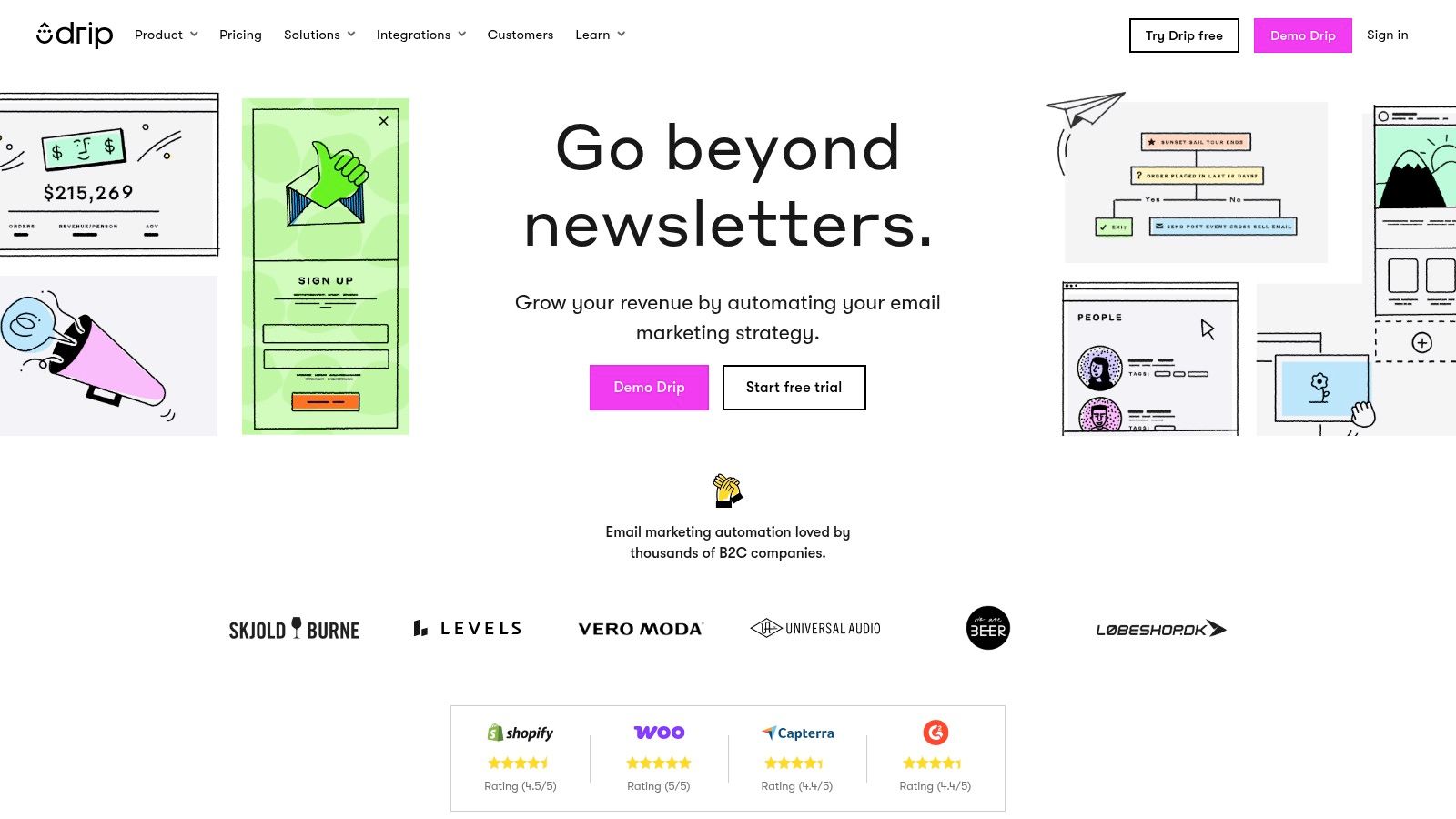
The platform’s strength lies in its sophisticated segmentation and personalization capabilities. Drip enables store owners to create highly targeted campaigns using a combination of events, tags, and custom fields, ensuring that every message is relevant to the recipient's place in the sales funnel.
Key Features & Use Cases
Drip excels at creating visual workflows that respond to actions like first-time purchases, abandoned checkouts, or viewing a specific product category. Its revenue and customer lifecycle dashboards provide clear, actionable insights into how marketing efforts are directly impacting sales. With over 90 integrations and dynamic content blocks, personalizing emails with product recommendations is straightforward.
- Best For: E-commerce businesses of all sizes that want to tie email marketing directly to sales and customer lifetime value.
- Standout Feature: Its e-commerce-centric reporting provides a clear line of sight from email campaigns to actual revenue generated, making it easy to prove ROI.
- Pricing: Starts at $39/month for up to 2,500 contacts, which includes all core automation and segmentation features. A 14-day free trial is available.
Pros and Cons
| Pros | Cons |
|---|---|
| Purpose-built for e-commerce with deep platform integrations. | Less suited to non-commerce use cases like blogging or SaaS. |
| Strong ROI and revenue tracking capabilities are built-in. | Live chat support is limited to plans $99/month and above. |
| Sophisticated segmentation and personalization options. | The interface can have a steeper learning curve than simpler tools. |
| Offers a comprehensive 14-day free trial to test all features. | Pricing is based on contact list size, which can become costly. |
Website: https://www.drip.com
10. Omnisend
Omnisend carves out its space in the market by offering an all-in-one email and SMS marketing automation platform specifically tailored for e-commerce businesses. Positioned as a strong mid-market alternative to platforms like Klaviyo, it combines powerful features with competitive pricing. Its core strength is unifying multiple communication channels, like email, SMS, and web push notifications, into a single, cohesive workflow, allowing merchants to create a truly omnichannel customer experience.
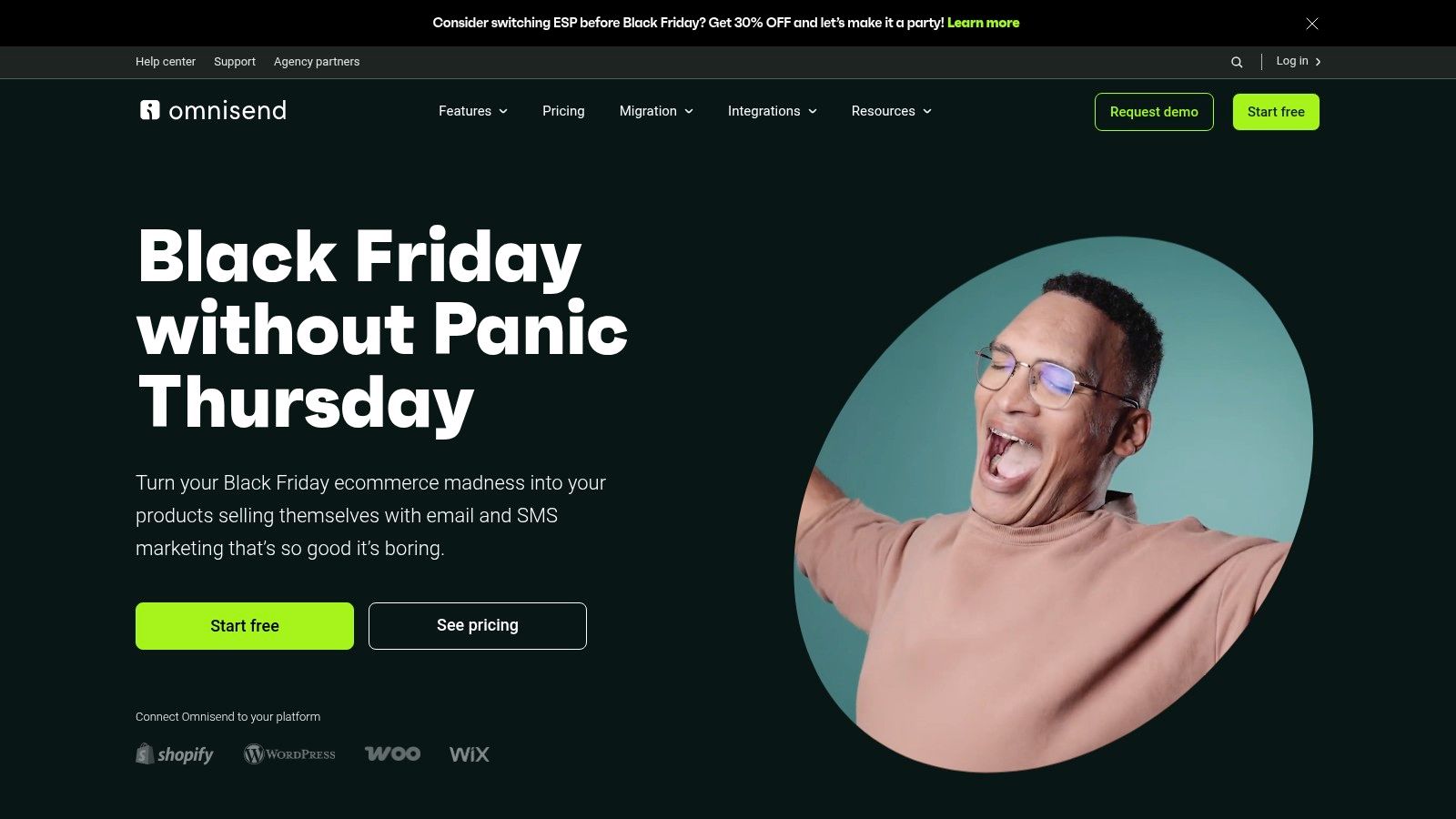
The platform is built around pre-built e-commerce automation flows, including cart abandonment, welcome series, and transactional emails, which significantly cuts down setup time. This focus makes it one of the best email automation tools for online stores looking for a fast, effective, and multi-channel solution.
Key Features & Use Cases
Omnisend’s feature set is designed to drive sales. Beyond standard campaigns, it includes signup forms, landing pages, and a robust audience segmentation engine that syncs with e-commerce platforms like Shopify and BigCommerce. With over 130 integrations, it connects your marketing efforts directly to your sales data, enabling highly targeted and personalized communication.
- Best For: Growing e-commerce stores that need a powerful, multi-channel (email, SMS, push) automation solution without the enterprise-level price tag.
- Standout Feature: The seamless integration of SMS and web push notifications into its automation workflows, complete with included monthly SMS credits on paid plans, simplifies creating a unified marketing strategy.
- Pricing: Offers a Free plan for up to 250 contacts and 500 emails/month. The Standard plan starts at $16/month, while the Pro plan ($59/month) unlocks unlimited emails and includes free SMS/MMS credits.
Pros and Cons
| Pros | Cons |
|---|---|
| Competitive pricing for e-commerce-focused features. | The free plan is quite limited in contacts and email sends. |
| Built-in SMS and web push notifications in one platform. | Some advanced personalization features are only on higher tiers. |
| Generous library of pre-built e-commerce automation recipes. | Interface can feel less intuitive than some simpler tools. |
| 24/7 priority support and migration assistance available. | A/B testing is not available on the Free plan. |
Website: https://www.omnisend.com
11. Salesforce Marketing Cloud
Salesforce Marketing Cloud is an enterprise-level platform designed for organizations that require a deeply integrated, multi-channel marketing automation engine. It moves beyond standard email campaigns to orchestrate complex customer journeys across email, SMS, push notifications, and advertising. Its core strength lies in its native integration with the broader Salesforce ecosystem, allowing businesses to leverage rich CRM data for hyper-personalized communication at an immense scale.
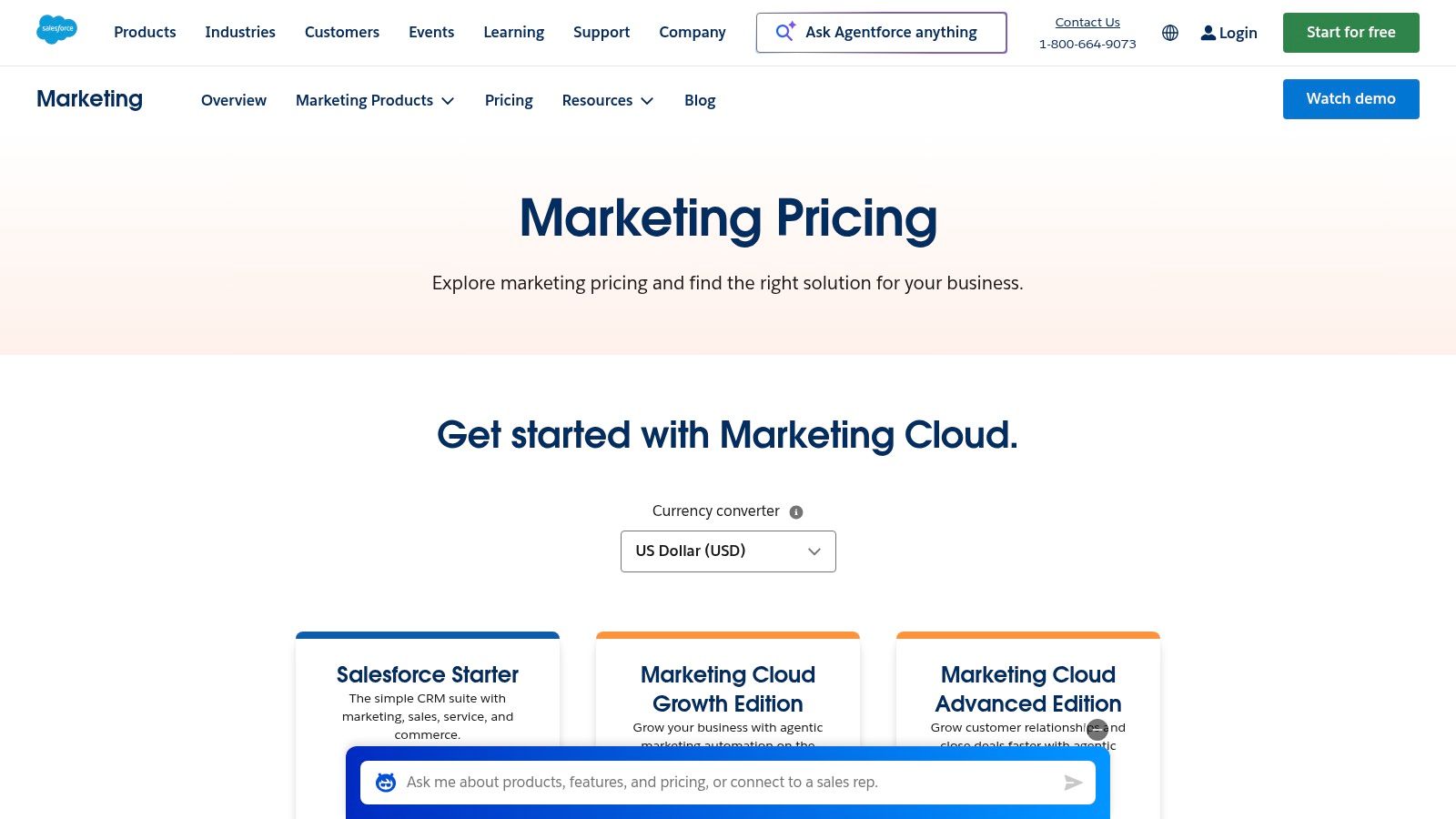
The platform's Journey Builder is a powerful tool for mapping and automating customer interactions based on real-time data and predictive intelligence, making it one of the best email automation tools for data-driven, enterprise marketing teams.
Key Features & Use Cases
Salesforce Marketing Cloud is built for sophisticated segmentation and personalization. It allows marketers to use AI-driven insights to predict customer behavior and deliver the right message at the right time. Its modular design means businesses can add powerful capabilities like advanced analytics (Marketing Cloud Intelligence) or loyalty program management as they grow.
- Best For: Large enterprises and corporations that are already invested in the Salesforce CRM ecosystem and need to manage complex, multi-channel customer lifecycles.
- Standout Feature: The native, bidirectional sync with Salesforce CRM provides an unparalleled 360-degree view of the customer, enabling automation triggers based on sales, service, and commerce interactions.
- Pricing: Pricing is customized and quote-based, typically involving annual contracts. Plans like Pro (starting around $1,250/month) include Journey Builder and personalization, with more advanced features in higher tiers.
Pros and Cons
| Pros | Cons |
|---|---|
| Extremely scalable with enterprise-grade governance and SSO. | Annual contracts; higher starting prices and required implementation effort. |
| Unmatched integration with the Salesforce CRM ecosystem. | Complexity can be overkill and overwhelming for small teams. |
| Manages true multi-channel campaigns (email, SMS, social). | Less intuitive UI that requires specialized training to master. |
| Broad ecosystem of data integrations and powerful APIs. | Customization and add-on modules can significantly increase costs. |
Website: https://www.salesforce.com/marketing/pricing/
12. Shopify App Store - Email Marketing category
For e-commerce entrepreneurs, the Shopify App Store’s Email Marketing category isn't a single tool but rather a curated marketplace of the best email automation tools designed specifically for the platform. This central hub allows merchants to discover, compare, and install powerful apps like Klaviyo, Omnisend, and Shopify’s own Shopify Email with a single click. Its primary strength is the deep, native integration these apps have with your store's data, from customer purchase history to abandoned checkouts.
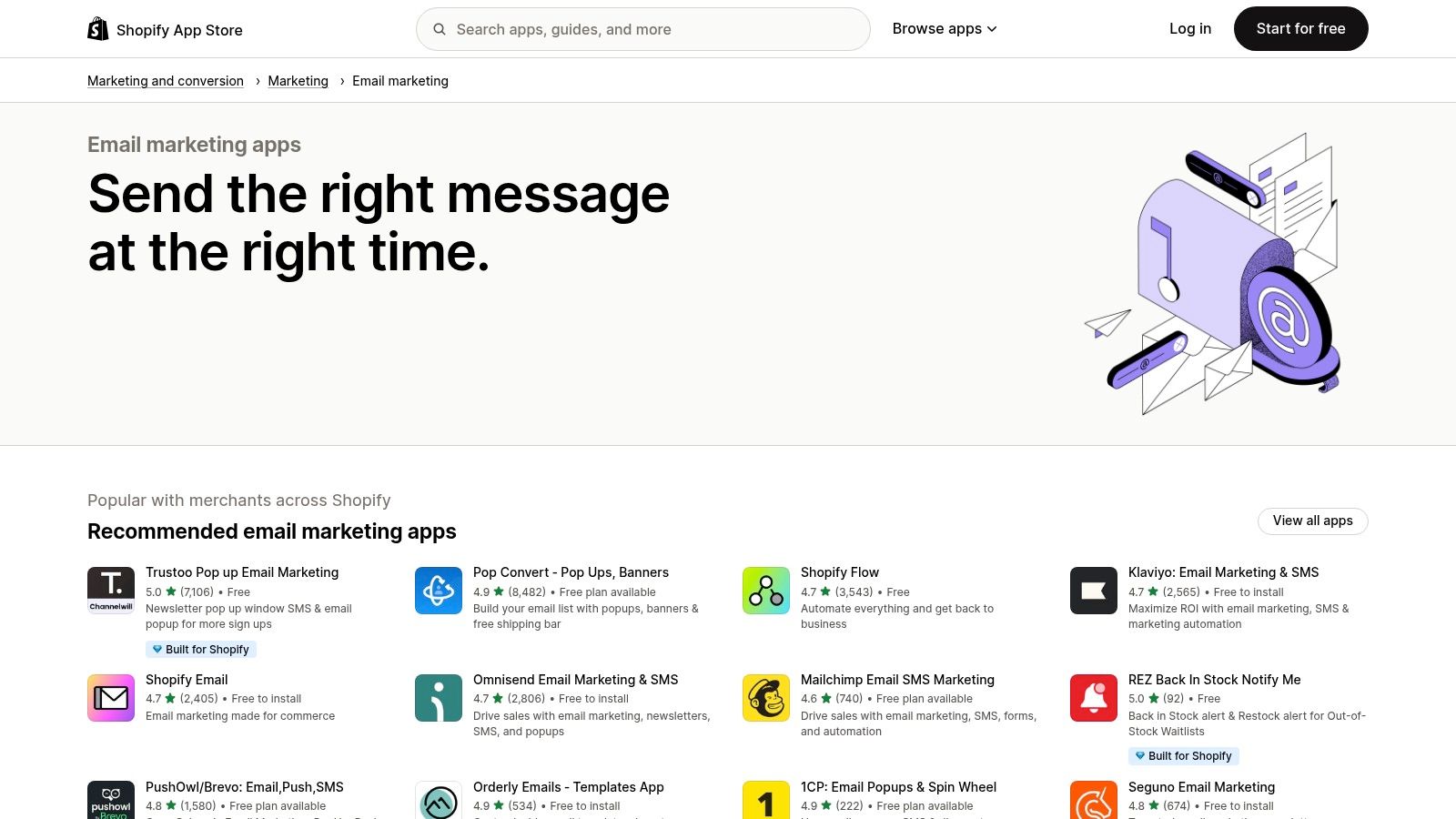
The ecosystem is built on trust, with transparent merchant reviews, ratings, and “Built for Shopify” badges that guarantee a seamless user experience. This makes it an ideal starting point for store owners who want to leverage their existing customer data without complex setup processes.
Key Features & Use Cases
The App Store simplifies the process of finding a tool that fits your exact needs, whether you're looking for basic campaign management or advanced, multi-channel automations. All billing is conveniently handled through your main Shopify account, and app listings clearly outline pricing tiers, free trials, and feature sets. This allows merchants to easily find solutions for cart abandonment, welcome series, and post-purchase follow-ups that pull product and customer information directly from their store.
- Best For: Shopify merchants of all sizes who prioritize seamless integration and want to find a purpose-built email solution without leaving their e-commerce ecosystem.
- Standout Feature: The direct, one-click installation and unified billing through a single Shopify account drastically reduce administrative overhead and technical friction.
- Pricing: Varies by app. Many top tools (like Klaviyo and Omnisend) offer Free plans for a limited number of contacts, with paid plans scaling based on list size or feature needs.
Pros and Cons
| Pros | Cons |
|---|---|
| Fast discovery and one-click installation process. | Can lead to "app sprawl" if multiple marketing tools are installed. |
| Deep, native integration with Shopify customer and product data. | Some apps require paid add-ons for SMS or more advanced features. |
| Trusted merchant reviews and ratings help in decision-making. | You are locked into the Shopify ecosystem. |
| Centralized billing simplifies subscription management. | The sheer number of options can be overwhelming for new users. |
Website: https://apps.shopify.com/categories/marketing-and-conversion-marketing-email-marketing
Top 12 Email Automation Tools Comparison
| Tool | Core Features/Capabilities | User Experience/Quality ★★★★✩ | Value & Price 💰 | Target Audience 👥 | Unique Selling Points ✨ |
|---|---|---|---|---|---|
| NotionSender 🏆 | Email integration inside Notion, AI data extraction | ★★★★☆ Easy no-code setup, intuitive UI | Free up to 100 saved & 50 sent emails; Premium unlocks 10k/5k emails & automation | SMBs, freelancers, project managers, marketers | Unique email per Notion DB, send & save emails in Notion, AI extraction, templated/scheduled sending |
| Mailchimp | Marketing automation, 300+ integrations, SMS addon | ★★★★☆ Large template library, scalable | Free tier; pay-as-you-go email credits; higher tiers unlock features | Small to mid-size marketing teams | Customer journey builder, AI writing assistant, transactional email |
| HubSpot Marketing Hub | CRM-powered marketing automation, reporting | ★★★★☆ Best-in-class CRM, seamless integrations | Free basic tools; Pro+ with onboarding fees and higher cost | Sales, marketing, service teams | Deep CRM integration, visual workflows, AI content tools |
| ActiveCampaign | Automation-first, 900+ integrations | ★★★★☆ Strong deliverability, robust workflows | Contact-tiered pricing, free 14-day trial | SMBs to mid-market teams | Visual automation builder, AI-assisted content, free coaching |
| Klaviyo | Ecommerce email/SMS automation, product feeds | ★★★★☆ Ecommerce triggers, predictive analytics | Free tier; pricing rises with active profiles | Direct-to-consumer ecommerce brands | Tight Shopify/WooCommerce integration, revenue-focused flows |
| Brevo (Sendinblue) | Email+SMS automation, simple CRM | ★★★☆☆ Budget-friendly, all-in-one automation | Low starting prices, no daily send limit on paid plans | SMBs seeking affordable multi-channel tools | SMS, WhatsApp, transactional APIs, send-time optimization |
| MailerLite | Simple email automation, landing pages, product sales | ★★★★☆ Clean UX, easy onboarding | Generous free tier; transparent pricing on paid plans | Creators, startups, small businesses | Visual automation, digital product sales, multivariate testing |
| Constant Contact | Email automation, event marketing, ads | ★★★☆☆ Very approachable, strong support | Fair pricing with overage policies | SMBs, event marketers | Event management, drag/drop editor, live onboarding |
| Drip | Ecommerce automation with revenue dashboards | ★★★★☆ Ecommerce-focused, ROI tracking | Pricing aligns with ecommerce value | Ecommerce brands primarily | Deep Shopify/WooCommerce/BigCommerce integration, lifecycle reporting |
| Omnisend | Ecommerce email+SMS, web push, templates | ★★★★☆ Competitive pricing, 24/7 support | Free limited plan; Pro with SMS credits | Ecommerce mid-market brands | Built-in SMS credits, web push notifications, advanced ecommerce flows |
| Salesforce Marketing Cloud | Enterprise multi-channel marketing automation | ★★★☆☆ Scalable, complex setup | High cost with annual contracts, implementation required | Large enterprises | Deep Salesforce CRM integration, multi-channel journeys, personalization |
| Shopify App Store (Email) | Marketplace for Shopify email marketing apps | ★★★☆☆ Easy install, curated apps | Varies by app; unified Shopify billing | Shopify merchants | One-click installs, merchant reviews, "Built for Shopify" badges |
Choosing the Right Tool to Automate Your Success
Navigating the landscape of the best email automation tools can feel overwhelming, but the journey to finding the perfect fit is a strategic process, not a game of chance. As we've explored, the ideal platform isn't necessarily the one with the longest feature list or the biggest name. Instead, it's the one that aligns seamlessly with your unique business model, technical capabilities, and most importantly, your core objectives.
The sheer diversity of options, from comprehensive CRMs like HubSpot and Salesforce to specialized e-commerce powerhouses like Klaviyo and Drip, highlights a critical truth: there is no single "best" tool for everyone. Your perfect solution is deeply personal to your business needs. A B2B service provider's requirements for lead nurturing and sales pipeline integration are vastly different from an online retailer's need for abandoned cart recovery and personalized product recommendations.
Key Takeaways and Final Considerations
Before making your final decision, reflect on the primary purpose of your email automation. Are you trying to convert leads, boost customer lifetime value, or streamline internal communications? Your answer to this fundamental question will immediately narrow down the field.
Remember these crucial factors as you weigh your options:
- Scalability is Non-Negotiable: Your chosen tool must grow with you. Consider not just your current contact list size and sending volume but also where you project your business will be in one, three, or even five years. Platforms like ActiveCampaign and MailerLite offer excellent scalability, allowing you to upgrade features and capacity as your needs evolve without a painful migration process.
- Integration is the Glue: An email automation tool rarely works in isolation. It must connect smoothly with your existing tech stack, whether that's your CRM, e-commerce platform, or internal project management system. Tools like Brevo shine with their extensive API and integration library, while unique solutions like NotionSender are built specifically to bridge the gap between your data hub and your email outreach.
- User Experience (UX) Dictates Adoption: A powerful tool is useless if your team finds it too complicated to use. The drag-and-drop builders in Mailchimp and Constant Contact are famously intuitive, making them great for beginners. Always take advantage of free trials or demos to get a hands-on feel for the platform's workflow builder and daily-use interface.
Your Actionable Path Forward
Making an informed choice requires a clear, methodical approach. Don't get distracted by shiny objects; focus on a structured evaluation.
- Define Your Top 3 "Must-Have" Automations: What are the most critical workflows you need to implement immediately? This could be a welcome series, an abandoned cart sequence, or a lead nurturing funnel.
- Set a Realistic Budget: Determine your monthly or annual budget, but also consider the total cost of ownership. Factor in potential overage charges for contacts or sends, and the cost of any necessary add-ons or integrations.
- Test Drive Your Shortlist: Select two or three top contenders from this list that seem to fit your criteria. Sign up for their free trials and build out one of your "must-have" automations in each. This practical test is the single best way to evaluate which platform feels most natural and powerful for your specific use case.
Ultimately, the goal of adopting one of the best email automation tools is to build a more efficient, profitable, and relationship-driven business. The right platform will feel less like a piece of software and more like a dependable, automated member of your team, working 24/7 to engage your audience and drive results. Choose wisely, implement thoughtfully, and you’ll unlock a new level of growth.
Ready to bridge the gap between your data and your audience? If you live and breathe Notion for managing your projects, CRM, or content, NotionSender is the missing piece in your automation puzzle. Turn your Notion databases into powerful, automated email campaigns without ever leaving your workspace by visiting NotionSender to see how it works.
